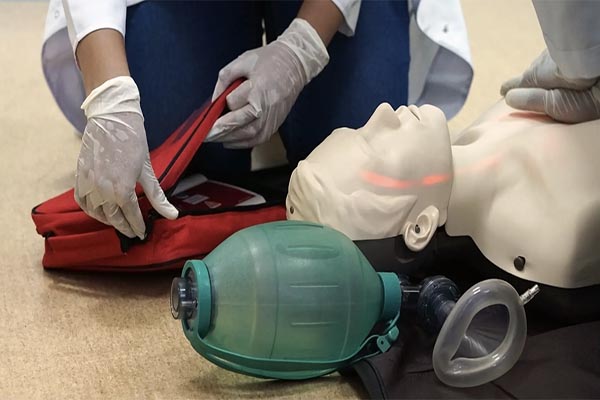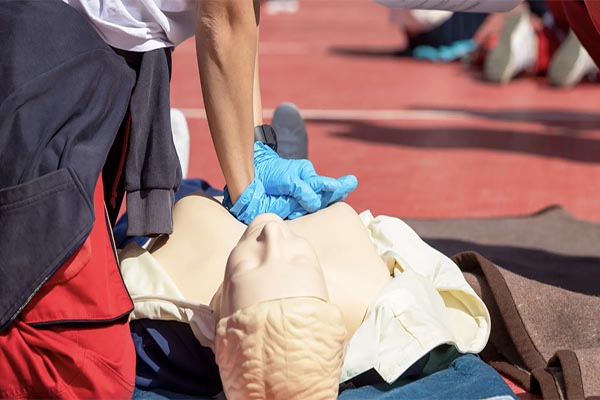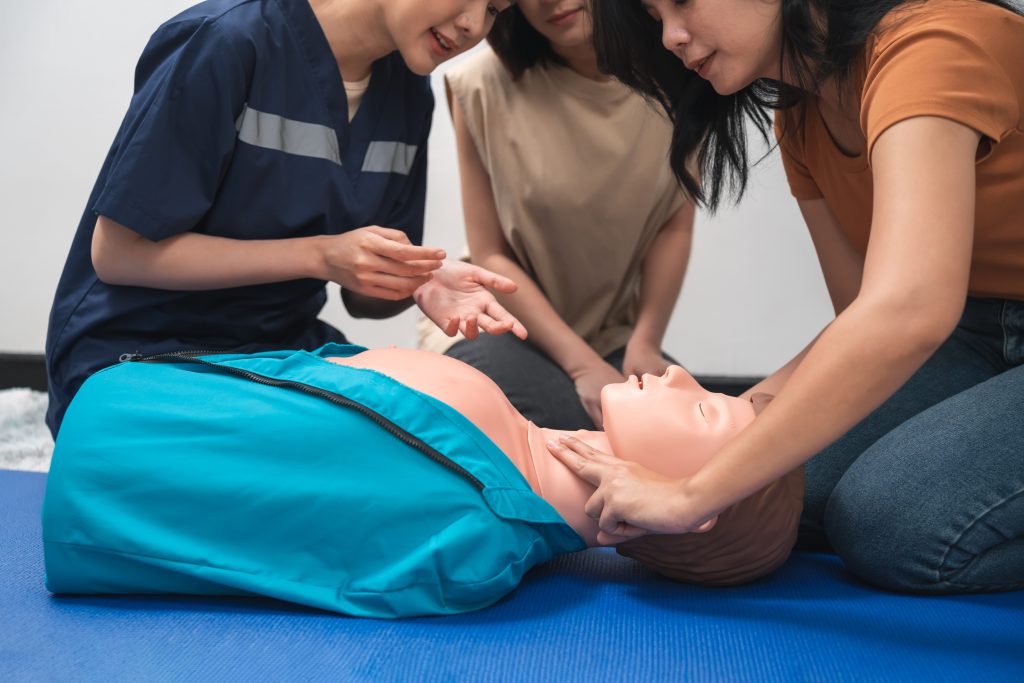
Baltimore, the vibrant hub of healthcare, education, and industry, demands a high level of preparedness from its workforce. The presence of world-class medical institutions and a dense population means that the risk of sudden medical emergencies is a daily reality. This is why having staff trained in CardioPulmonary Resuscitation (CPR) is not just a benefit; it is often a non-negotiable requirement.
When a life-threatening emergency occurs, minutes, or even seconds, matter. Properly executed CPR can double or even triple a person’s chance of survival following cardiac arrest. This procedure helps maintain vital blood flow to the brain and other critical organs until professional medical responders can take over.
The question for many job seekers is not if they should get certified, but how. The market is flooded with quick, inexpensive online options promising instant credentials. However, Baltimore employers overwhelmingly stand firm on one requirement: the training must be hands-on and in-person. They understand that a critical, life-saving skill cannot be mastered by watching a video alone. The distinction between a certificate earned in a comfortable armchair and a certification earned through rigorous practice is a matter of life and death.
This comprehensive guide will delve into the core reasons why hands-on, American Heart Association (AHA) aligned training is the definitive standard in Baltimore, and why employers simply will not settle for anything less.
What is the Fundamental Difference Between In-Person and Online CPR Training?
The fundamental difference lies in skill acquisition and verification. Online courses are excellent for learning the cognitive component—the what and why of CPR. They teach you the procedures and the theoretical knowledge necessary for understanding an emergency.
However, they universally fail at the most crucial part: the psycho-motor skill application. CPR is a physical, tactile skill that requires mastery of depth, rate, and rhythm.
Here is a breakdown of the key difference:
- In-Person Training: Focuses on the physical execution of skills.
- Hands-On Practice: Students work directly on realistic manikins.
- Tactile Feedback: They learn the correct depth (at least two inches for adults) and rate (100 to 120 compressions per minute).
- Instructor Correction: A certified expert watches, corrects hand placement, and ensures technique is flawless.
- Skill Testing: Students must pass a physical skills test to prove competency.
- Online Training: Focuses exclusively on the theory.
- Video Instruction: Students watch demonstrations.
- Self-Assessment: Knowledge is tested via multiple-choice quizzes.
- No Physical Verification: There is no mechanism to verify the student can perform chest compressions correctly or use an AED under pressure.
- Certificate, Not Certification: Often results in a certificate of completion, which is distinct from a certified, verifiable skill card.
Ultimately, an in-person class is the only way to prove you can actually save a life, not just describe how to save one.

Why Do Baltimore Employers Specifically Demand Hands-On Skill Verification?
The requirement for hands-on, in-person training is driven by legal, ethical, and practical considerations essential to maintaining a safe and reliable workforce. Employers are responsible for the safety of their clients, patients, and employees.
By mandating a verified, in-person certification, employers protect themselves, their staff, and the public they serve.
Key reasons for the hands-on requirement include:
- Compliance with Industry Standards: Many Baltimore sectors, particularly healthcare (e.g., hospitals, clinics), require the official AHA Basic Life Support (BLS) credential.
- The AHA dictates that the hands-on portion is mandatory for credential issuance.
- Mitigation of Liability Risk: If an employee performs CPR incorrectly during a genuine emergency, resulting in a poor outcome, the employer could face significant liability.
- An in-person class provides documentation that a certified instructor verified the student’s physical competence.
- Ensuring Effective Intervention: A certification is useless if the holder freezes or performs ineffective compressions when seconds count.
- Hands-on practice builds muscle memory and confidence, leading to a faster, more effective response during a real crisis.
- Completing the Training Spectrum: CPR involves two core components: cognitive (knowledge) and psychomotor (skill).
- The hands-on component completes the training by verifying the physical ability to perform rescue breaths, compressions, and manage an airway.
Employers in Baltimore know that a certification card issued after watching a video is insufficient proof of life-saving ability.
Which Baltimore Industries Require In-Person AHA BLS Certification?
The demand for high-quality, verifiable CPR training extends far beyond the medical field in Baltimore. While the local healthcare industry is the most obvious area of need, numerous other sectors mandate this specific, hands-on certification.
If you are seeking employment in any of the following fields in the greater Baltimore area, expect an in-person AHA BLS card to be mandatory:
Healthcare Professionals
- Nurses (RNs, LPNs, CNAs): Required for hospital and clinic privileges.
- Medical Office Personnel: Often required in smaller practices that need staff to be emergency-ready.
- Dental Staff: Including dentists, hygienists, and assistants.
- Physical and Occupational Therapists: Required due to high-risk patient interaction.
Education and Childcare Roles
- Teachers and Educators: Especially those in physical education or specialized programs.
- Daycare and Childcare Workers: Often required to hold Pediatric CPR certification, which involves specific infant and child techniques.
- Coaches and Referees: Necessary for managing potential cardiac events during athletic activities.
Public Service and High-Risk Environments
- Construction Workers and Electricians: On-site emergencies require immediate response.
- Flight Attendants and Hospitality Staff: Required due to the need to handle emergencies in confined spaces.
- Swim Instructors and Lifeguards: Mandated by law and safety protocols.
Fitness and Wellness
- Personal Trainers: Required to manage client risks during intense workouts.
- Gym Staff: Any employee managing facility safety is typically required to be certified.
In all these industries, the certification must adhere to the highest standard, which is why the American Heart Association (AHA) Basic Life Support (BLS) course is the credential of choice.
Why is the American Heart Association (AHA) BLS Credential the Gold Standard?
The American Heart Association (AHA) is the universally recognized authority on cardiovascular science and emergency cardiac care. Its guidelines are rigorously researched and updated, serving as the basis for almost all other life support protocols worldwide.
When Baltimore employers ask for a “CPR Certification,” they almost always mean an AHA-aligned certification, specifically the BLS (Basic Life Support) Provider card.
Here is why the AHA BLS standard is non-negotiable:
- Scientific Foundation: AHA guidelines are based on the latest scientific consensus and research.
- Universal Acceptance: It is the most employer-accepted certification nationwide, particularly within the healthcare system and for OSHA compliance.
- Comprehensive Curriculum: The BLS course covers critical elements that go beyond basic CPR, including:
- Effective chest compressions for adults, children, and infants.
- Proper use of an Automated External Defibrillator (AED).
- Airway management and relief of foreign-body airway obstruction (choking).
- Team dynamics and communication during a resuscitation effort.
- Standardized Quality: Being an AHA Certified Training Site means the provider adheres to strict standards regarding equipment, instructor qualifications, and mandated class length (approximately 3.7 hours).
If a potential employee presents a non-AHA certification, the employer must spend time verifying its legitimacy and comprehensiveness, which most are unwilling to do. They default to the trusted, verifiable AHA standard.
Can I Truly Master Compression Depth and Rate Without Hands-On Practice?
No, the mastery of chest compression depth and rate is impossible to verify or perfect without a hands-on component and direct feedback. This is the single largest flaw in purely online CPR courses.
Consider the physical requirements of effective CPR:
- Correct Depth: Adult compressions must be at least two inches deep.
- Correct Rate: The rate must be between 100 and 120 compressions per minute.
- Full Recoil: The chest must be allowed to fully recoil after each compression.
Can you learn this from a video? You can learn the numbers, but you cannot learn the feel.
The Role of Manikins and Instructor Feedback
In a quality in-person class, students practice on manikins equipped with feedback devices. These devices often light up or beep to indicate when the student achieves the correct depth and rate.
Key benefits of practicing on a manikin include:
- Developing Muscle Memory: Repeated physical actions build the involuntary response needed in a panic situation.
- Gauging Applied Force: Students learn exactly how much force is required to achieve two inches of compression.
- Real-Time Correction: The instructor immediately intervenes if the student is pressing too fast, too slow, too shallow, or is using improper hand positioning.
- Simulating Fatigue: Practicing for two minutes straight (the required cycle length) simulates the physical fatigue encountered in a real emergency, preparing the rescuer for the stamina required.
A video cannot tell you if your compressions are two inches deep. Only a certified instructor watching your performance can do that. Baltimore employers understand that the difference between 1.5 inches and 2 inches can be the difference between failure and survival.

How Do Online Certifications Mislead Job Seekers Regarding Acceptance?
Many online CPR programs are careful with their wording, promising “certification accepted nationwide” or claiming to be “OSHA compliant.” While technically true for some non-medical, low-risk jobs, these claims often hide critical exclusions that make them useless for the Baltimore professional seeking high-demand employment.
The core issue is the difference between knowledge and skill.
The Cognitive vs. Psychomotor Gap
- Cognitive Completion: An online course certifies that you watched the video and passed the multiple-choice test. It is a cognitive completion certificate.
- Psychomotor Deficiency: It fails to certify your psychomotor skills, the physical actions.
The AHA’s position is clear: any certification requiring psychomotor skills (like BLS) must have a hands-on component supervised by an authorized instructor.
When an online provider claims acceptance:
- They often mean acceptance of their knowledge content. Employers are interested in the skill.
- They may be referring to hybrid courses. A hybrid course requires the online portion, but it always requires a separate, in-person skill session and testing to be a valid AHA certification.
- They do not distinguish between low-risk and high-risk requirements. A warehouse employee may be allowed an online course, but a CNA applying to a Baltimore hospital will be immediately rejected without the physical skills card.
To avoid wasting time and money, job seekers should always confirm that the training issues an official, employer-recognized eCard from the American Heart Association, which necessitates an in-person component.
What is the Value of Receiving a Same-Day Certification Card in Baltimore?
The job market in Baltimore is competitive and fast-paced, particularly in critical sectors like healthcare. When an employer asks for proof of CPR certification, they usually need it immediately to process the hiring paperwork. Waiting weeks for a physical card to arrive is often impractical.
This is where local, certified training sites offer a critical advantage over delayed processing systems.
Key benefits of same-day certification:
- Immediate Employability: Once the hands-on session is successfully completed, the instructor can issue the AHA BLS eCard instantly.
- No Lapse in Coverage: For renewal students, a same-day card ensures there is no gap between the old certification’s expiration and the new one’s validity.
- Streamlined HR Process: Employers can easily verify the card online using the AHA’s dedicated system, speeding up the onboarding process.
- Proof of Local Compliance: Receiving the eCard directly from a Baltimore-based AHA Training Site demonstrates that the student has met the local, regional standards expected by employers.
The convenience and speed of the same-day eCard is a crucial service that only dedicated, fully certified in-person providers can offer.
Does In-Person Training Cover the Use of an Automated External Defibrillator (AED)?
Yes, the proper use of an Automated External Defibrillator (AED) is a core component of American Heart Association Basic Life Support (BLS) training and is thoroughly covered in all quality in-person courses.
The integration of AED training into CPR certification is essential because sudden cardiac arrest requires both chest compressions and, often, an electrical shock.
The hands-on training ensures mastery of the AED by:
- Practicing Deployment: Students learn where to place the AED pads on an adult, child, or infant manikin.
- Following Prompts: They practice turning on the device and following the verbal prompts under simulated stress.
- Minimizing Interruptions: A crucial skill is delivering the shock with minimal interruption to chest compressions, a skill that requires physical timing and coordination.
- Troubleshooting: Instructors guide students on how to handle common issues, such as a “check pads” error or understanding when not to touch the patient.
AEDs are becoming ubiquitous in Baltimore workplaces, schools, and public spaces. An employer requires a certified individual who is confident and proficient in using this life-saving piece of technology.
What Should I Look for When Choosing an In-Person CPR Class Near Me?
Selecting the right training partner is essential to ensure your time and money result in a genuinely accepted and valid certification. When looking for “CPR certification near me” in Baltimore, focus on quality, recognition, and service.
Here are the non-negotiable criteria for selection:
- AHA Certified Training Site: This is the single most important factor. Verify they are authorized to issue official American Heart Association eCards.
- BLS Provider Course: Ensure the course is the Basic Life Support (BLS) Provider level, as this is the designation required by most professional employers.
- Hands-On Practice: Confirm the course is fully in-person or a blend (hybrid) that includes a mandatory, supervised, in-person skills session.
- Same-Day eCard Issuance: Look for providers who guarantee your eCard will be issued by the instructor on the same day you complete the class.
- Local Expertise: Choose a provider that serves the greater Baltimore area (including regions like Annapolis, Columbia, and Towson), indicating they understand local employer needs.
- Group Training Options: If you are an employer, check for on-site group training capabilities to certify your entire team conveniently.
By adhering to these standards, you ensure your certification is immediately recognized and valid throughout the Baltimore job market.
Conclusion: Securing Your Future with a Confident, Verified Skill
The verdict from Baltimore employers is clear and unwavering: when it comes to saving a life, there is no substitute for verified, hands-on training. The convenience of a purely online certificate simply cannot outweigh the necessity of proven, life-saving skill. For professionals across the healthcare, education, childcare, and industrial sectors, the American Heart Association BLS in-person card is the definitive credential.
By choosing a dedicated, local AHA Certified Training Site, you are not just obtaining a piece of paper; you are investing in a critical, real-world skill that enhances your professional profile and, most importantly, prepares you to act decisively in an emergency. Ensure your certification is accepted the first time by committing to the gold standard. Do not risk your job or, worse, a life, on an unverified online course.
Take the necessary step to secure your employment and safety credentials today.
Ready to meet Baltimore’s employment standards? Contact CPR Classes Near Me to book your American Heart Association BLS CPR and AED certification class.
Contact CPR Classes Near Me to schedule your required in-person training.
Frequently Asked Questions About The Importance Hands On CPR Training
Is it true that I cannot take my CPR Certification completely online for professional jobs?
Yes, it is true. While you can often take the knowledge-based portion of a course online, professional Baltimore employers, especially in healthcare, childcare, and education, require the full American Heart Association (AHA) Basic Life Support (BLS) certification. Effective CPR training necessitates in-person, hands-on instruction to verify your skills. Employers typically do not accept certifications obtained exclusively online because they lack verified physical skill competency, which is a significant liability risk.
How long does an in-person CPR certification class take?
The duration of the in-person class is standardized by the American Heart Association. Most accredited AHA Training Sites are required to show the complete video content and conduct the hands-on practice. The typical in-person BLS course, which includes the necessary training and testing, takes approximately 3.7 hours to complete.
How long is my AHA CPR certification valid for?
Upon the successful completion of your in-person training course and skills assessment, you will be awarded an official AHA CPR certification (eCard) that is valid for two years. The AHA certification is the most widely acknowledged qualification by employers across the country, whether you are in healthcare or not.
How much do AHA CPR classes generally cost in the Baltimore area?
The cost of AHA CPR classes in the Baltimore area can vary depending on the provider and the type of course. Generally, you can expect to pay between $60 and $100 for a standard BLS CPR course. Courses that bundle First Aid with CPR often cost slightly more (e.g., around $80 to $120). It is important to remember that slightly cheaper, exclusively online courses often do not provide the official, employer-required training credentials.
Who is required or encouraged to take a CPR class?
Anyone capable of completing the course independently is strongly encouraged to learn CPR, as emergencies can happen anywhere. There is no official minimum age requirement to become AHA certified. The AHA BLS CPR certification is highly valuable for anyone who needs to be prepared to provide critical care in emergencies, including:
- Healthcare providers (nurses, CNAs, medical assistants).
- Teachers and school staff.
- Fitness professionals and coaches.
- Childcare and daycare providers.
- Construction and utility workers.
- Any individual who wants the preparedness to save a life.
Can I renew my AHA certification, or do I need to take the full class again?
Yes, you can absolutely renew your certification. The Renewal Class and the initial in-person BLS course are functionally identical, as they both require the full review and skills check. To extend your CPR certification for an extra two years, you simply enroll in any scheduled BLS or First Aid course. The process helps you refresh your life-saving skills and prepare for any emergency situation.

Leave a Reply